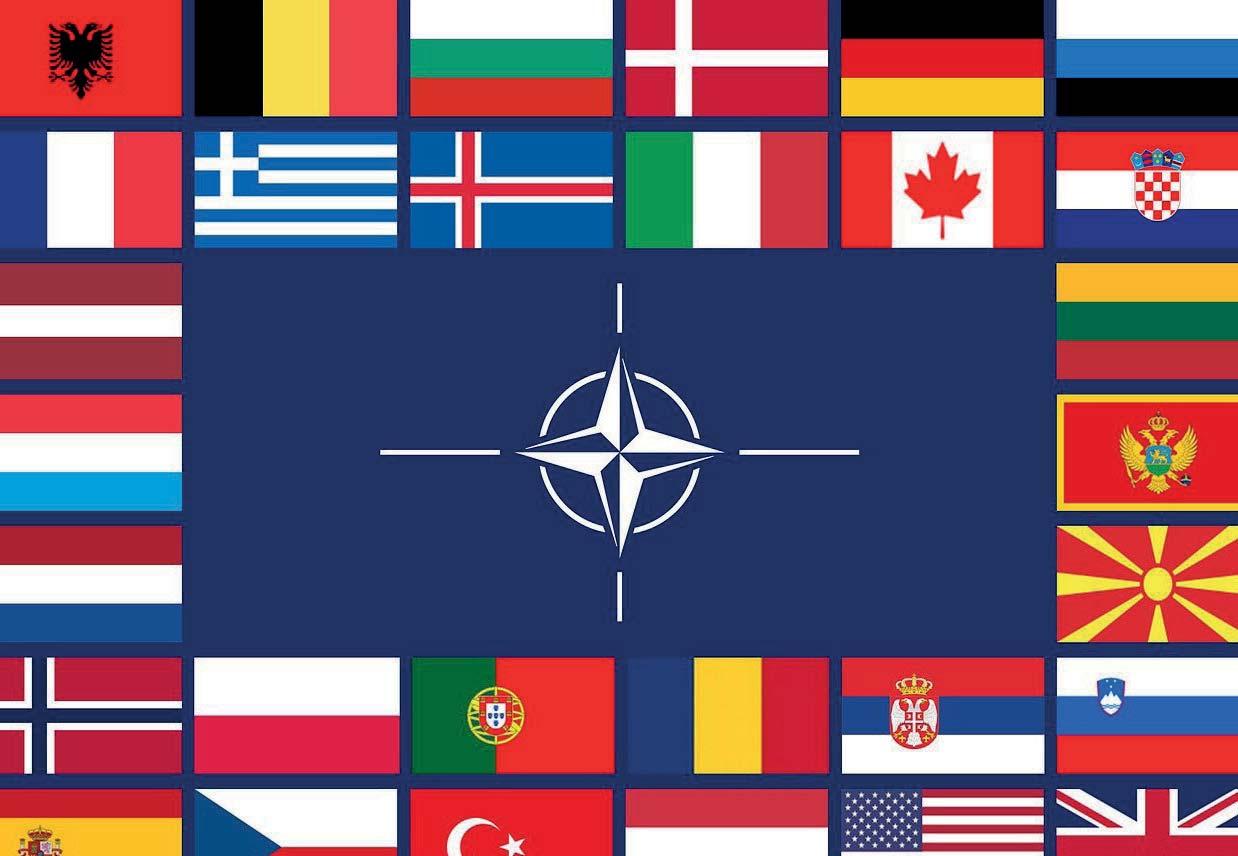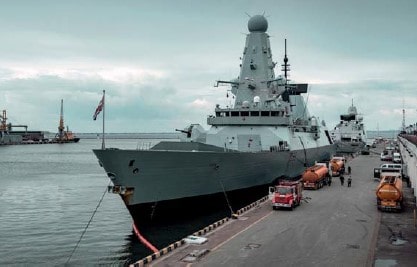
11 minute read
6 KEY CHALLENGES NATO
from IA Y VALORES
by GS Magazine
SIX KEY CHALLENGES FACING NATO IN THE AREA OF PUBLIC DIPLOMACY
Dr. Cristina Vanberghen
Professor and Senior Expert at the European Comission
In order to further expand on its achievements, NATO must continue its cooperation in the area of public diplomacy along the route of becoming a fully fledged e-organisation served by the best highly motivated international officials.
Allies have different threat perceptions and security concerns. Therefore, it would be essential to align the public communications efforts of NATO member nations with that of NATO itself. Coordination is of great importance. Campaign Approach is useful in reaching out to the target audience. Emerging and disruptive technologies have become an important game changer. NATO must keep innovation in its focus and maintain its edge over its adversaries be they State or non-state actors. In the communications realm NATO should be up to speed up in terms of making greater use of EDTs, AI and processing big data. Digital communication is key in success especially considering the young generations’ use of social media platforms.
In addition to the cutting-edge communications tools, building up the communication skills of staff is one of the soundest investments NATO can make. Not only does it help them stay relevant, it also amplifies their message, which increases their chance of having an impact.
In addition, a strong close cooperation between ASG and NATO Spokesperson lays the foundation for a more open, connected, and engaged NATO. Engaging with media and providing journalists with factual, well-tailored and continuous information on the activities of NATO, it is also important for holding a constructive dialogue using all available audiovisual and technical facilities.

Internally, all necessary processes must be designed, and actions taken to facilitate the response to the following challenges:
Development and effective implementation of a NATO-wide communications effort that successfully incorporates and leverages Allies’ national communications campaigns
With its Strategic Concept, NATO agrees on a common strategic vision for its role in the world and commits to a set of concrete and wide-ranging objectives to achieve these goals in the future.
But as ever, the devil is in the detail. In order to reflect this new vision, NATO needs to solidly implement its “Strategic Concept” through its Annual Communications Strategies that define the approaches to be followed and the Strategic Communications Frameworks for specific topics and detailed Integrated Communications Plans. The real metric for its successful implementation is successful public diplomacy which leads to concrete results, and combining top-down strategic communication initiatives through strong civic multi-stakeholder partnerships. The Strategy should create more space and a better engagement with civil society worldwide, bringing visibility to NATO’s pledge in the future, moved by new development strategic interests –not only by classic development goals.
To further expand on its achievements, I would argue that NATO must enhance its strategic communication worldwide. All necessary strategic processes must be designed, and actions taken to facilitate the response to the new challenges: procedures, strategies, assessments, indicators and programs have to maximize the benefits of the new NATO Strategic Concept. Beyond the technical capabilities of the strategies emerging from the Strategic Concept - which help to create trust-building and powerful international relationships - NATO’s public diplomacy must continue its actions to strengthen and measure the practical implementation of its strategies, including through developing reliable indicators to measure and then maximise its impact in the world.
Under the authority of the Secretary General, and with support of stakeholders based on both internal and external consultation, and in strong collaboration with my team, my objective will be to prepare and coordinate a Strategic Communication Plan based on the following actions:
undertake a stakeholder mapping for the NATO, both external and internal, taking note to integrate NATO’s extensive civilian structure and the NATO delegations and map the relevant communication needs;
ensuring a strong partnership with the NATO ‘delegations, the role of public diplomacy will be to engage with citizens, national authorities, media and stakeholders on the ground; focus in particular on target audiences and the most appropriate communication tools and channels;
review the previous and current communication strategies and processes used by the NATO to determine good practices, gaps and opportunities, analyse their effectiveness in terms of new political priorities. review strategic documents including the Action Plans (if available), policy documents and projects to map communication and information dissemination requirements;
engage stakeholders to develop a comprehensive communication strategy, outlining measures and strategies to be adopted by NATO;
conceptualize, and develop NATO materials with appropriate and relevant messages tailored for key stakeholders using various formats and specify the appropriate communication channels, dissemination methods and media such as video, print, web/online media, traditional media, and social media, among others, to effectively communicate key messages to specific stakeholders;
jointly work with the NATO teams to develop key messages and dissemination strategies, including for social media.
The Russian war has caused an unprecedented shift in Allies' policies on defence and commitments to investment. The role of the Strategic Communication Plan will be to support NATO’s efforts to maintain the necessary political will and budgets to ensure successful implementation of its Strategic Concept launched in Madrid, through innovative projects and sufficient financial contributions to realise the implementation of the Strategic Concept’ goals.
2. Development and use of cutting-edge communications tools to ensure that NATO’s priorities and messages are clearly and effectively communicated to key audiences
NATO should become a modern, high-performing administration by continuously adjusting its tools and products to face the challenges of the constantly evolving communications environment.
In this context, exploring the development and use of cutting-edge communications tools is more important than ever. Cutting-edge tools could enhance the dialogue and contribute to the public perception of NATO’s work / achievements while helping to convey its positive image. In the digital era, most of this communication will be delivered to citizens via digital channels to bring NATO closer to people. As the competition for people's attention and the demands on their time is increasingly intense, in order to succeed, NATO needs to understand better recipients needs and interests, personal or professional. For this, communication needs to be evidence-based and put the user first. With the active contribution of NATO's Public Diplomacy Division (PDD), my priority will be to support NATO to base its decisions related to communication on data and evidence.
NATO staff need to receive high quality communication advice and intelligence, with messages aligned to the NATO priorities. This, in turn will have an impact on how well-informed citizens feel. Providing prompt information, clarifying issues, tackling the spread of online disinformation and misinformation to ensure the protection of democratic values is more important than ever. The way in which people consume information is changing almost daily. If an organization wants to be heard, it needs to get better at expressing itself and become more attuned to how people listen.
In addition to the cutting-edge communications tools, building up the communication skills of staff is one of the soundest investments NATO can make. Not only does it help them stay relevant, it also amplifies their message, which increases their chance of having an impact.
It is important to have a close cooperation with NATO Spokesperson. Engaging with media and providing journalists with factual, well-tailored and continuous information on the activities of NATO, it also important for holding a constructive dialogue using all available audiovisual and technical facilities. Technologies such as big data, artificial intelligence (AI), autonomous systems and quantum technologies are changing the world, and the way NATO operates. These and other emerging and disruptive technologies (EDTs) present both risks and opportunities for NATO and Allies.
That is why it will be important to engage with public and private sector partners, academia and civil society to establish international principles of responsible use of EDT’s and maintain NATO’s technological edge.
NATO's Public Diplomacy Division (PDD) needs to roll out an ambitious program of cooperation which enhances the NATO-EU strategic partnership, strengthen political consultations and increase cooperation on issues of common interest, such as military mobility, resilience, the impact of climate change on security, emerging and disruptive technologies, human security, the Women, Peace and Security agenda, as well as countering cyber and hybrid threats and addressing the systemic challenges posed by the PRC to Euro-Atlantic security.
3 Fight against disinformation
NATO is active in combating disinformation. Ranging from the production of communication products (including videos and social media posts) to the creation/coordination of network against disinformation, NATO must continue fighting disinformation, debunking myths and informing citizens about how they can protect themselves.
As part of its communications strategy, combating disinformation in the context of the new hybrid threats is a key element. In this respect, programmes have been launched to analyse the information space, such as "Setting the Record Straight", in order to detect trends in disinformation and to be able to react more quickly and develop specific content.
In my view, we could create a joint EU-Nato information-sharing mechanism to combat disinformation and foreign digital interference. With Russia deploying cyber warfare and disinformation strategies in its war on Ukraine, online platforms and internet service operators play an important role in dispatching factual information. Considering the borderless nature of the
Internet, it will be more effective to do this via greater international collaboration by establishing a joint information-sharing system focusing on disinformation and information manipulation in the context of the Ukraine war, including new approaches to mitigate the threats.
4. Citizens engage with NATO through face-to-face events and online interactive platforms
NATO communicates with citizens and helps raise awareness and understanding of the Alliance and Alliance-related issues and, ultimately, to foster support for, and trust in, the Organization. Since NATO is an intergovernmental organisation, individual member governments are also responsible for explaining their national defence and security policies as well as their role as members of the Alliance to their respective publics.
On the other hand, NATO, through its different divisions, interacts with citizens in a wide range of activities and NATO Representations and delegations organise a wide range of debates and conferences.
NATO engage proactively (both in face-to-face and online modes) with civil society and promotes awareness of the Alliances, its actions, and its future; the organised visits of the Secretary General give citizens the opportunity to gain insights into the work and functioning of the NATO and to discuss the various NATO challenges.
NATO should interact even more with citizens remotely, for example through social Media platforms.
5. Cooperation and Transparency
The challenges of cooperation and transparency are linked with the implementation of the New Strategic Concept. A reinforced cooperation, at all levels, will be a step forwards transparency and it will allow us to reinforce trust and spread best practices. And over the coming years, we can explore the possibility of rolling out an ambitions programe of public diplomacy including also NATO-EU cooperation. The aim of such a public diplomacy could be based on a “co-creative” spirit, creating a unified framework that integrates tools for communication.
This is even more important since we are facing many challenges including social media as a tool of public diplomacy. The ability to have daily online material that can be noticed in the online sea of information, could have an important impact on the visibility of the EU-NATO public diplomacy in areas of common interest.
6. Vision to develop and implement the necessary policies and challenging your team
In the next 5 years, NATO will go through a major process of transformation, one which in turn will require transformational leadership, in order to revisit the organisation’s core mission, develop staff competency levels and organise re-deployment, support knowledge management, improve internal communication, and instil a cooperative culture. NATO should encourage innovation, and innovation can come from anywhere, from any level, and at any time. We need to listen and be respectful of the voices of all staff and all stakeholders in order to develop new collaborative partnerships. We need to
bring innovative thinking into the NATO's work, from strategy to implementation.
NATO should be able to genuinely partner with entrepreneurs and technology companies, small businesses, researchers, universities, government, civil society, and development practitioners to keep NATO at the forefront of cybersecurity, enable it to incorporate breakthrough innovations, and apply the best tools to emerging priorities.











